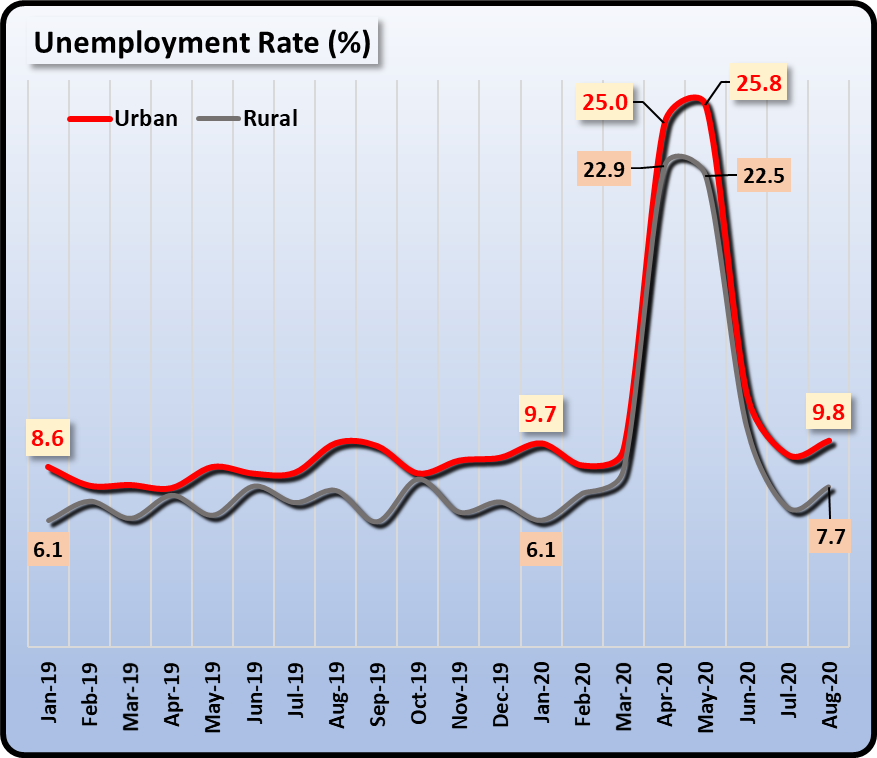Finally, Modi Govt Wakes Up to Urban Joblessness – Or Does it?

Unemployment has been running at staggeringly high levels in India’s urban areas for the past several months. It had averaged about 7% in 2018 and risen to over 8% in 2019, then zoomed up to an incredible 26% during the recent lockdown. After falling to about 12% in June and further to 9.2% in July, in August 2020 it is estimated at nearly 10%. All these figures are from CMIE’s periodic surveys, which are the only source of such high frequency data. These urban rates have been consistently higher than those for rural areas. [See chart below]

However, the Modi government has been eerily silent on this crisis. Through all the razzmatazz of the government’s publicity machinery - the ‘addresses to nation’, the Man Ki Baats, the web portals and social media armies – the plight of urban jobless, especially the educated youth, was missing. This was the constituency that Modi and the BJP had assiduously nurtured, fed them dreams of Global Superpower etc. To be fair, this had been readily swallowed by urban middle class.
Yet, as the chart shows, a simmering crisis was continuing. Recently, there have been a flurry of reports that the government is considering starting an urban employment guarantee scheme on the lines of the popular rural scheme (MGNREGS). A bureaucrat from the housing and urban affairs ministry has been quoted as saying that the government has been considering it since last year. He in fact went on to suggest that Rs 35,000 crore may be spent on it, and that it may be started in smaller cities.
As of January-April quarter of this year, the urban labour force (that is all those employed as also unemployed) was estimated by CMIE at 14.5 crore of which some 11.7 crore were employed. That leaves about 2.8 crore persons. Of these 1.7 crore were unemployed and actively seeking it while another 1.1 crore were those who were unemployed, willing to work but become so frustrated that they were not actively looking for work. This broader category of unemployment is called ‘greater unemployment’ by CMIE and is a better picture of the reality.
Also read: Job Situation Continues to Be Grim Despite ‘Unlock’ and Govt’s Concessions to Rich
So, what the Modi government is feeling the heat about is this 2.8 crore unemployed in urban areas. About 60% of them are below 29 years of age.
Lockdown Effect
As we well know, the ill-conceived lockdown announced by Modi on March 24 this year had led to abrupt and catastrophic closure of the economy, especially the industrial and services sectors, that are largely located in urban areas. This is what led to the mass return migration of lakhs of workers from major cities back to their villages. Unemployment in cities and towns jumped to nearly 26% in May, compared to 22% in rural areas. This is despite the fact that many migrant workers had already left for their villages – they could not have been counted in urban centres.
Since then, the situation has “improved” in the sense that unemployment rate has been reported as falling to about 10% in August. But what is this new ‘employment’ that people in urban areas are working at?
Most of the industries are either closed or functioning at very much reduced capacity. Markets and offices, too, are either closed or partially opened. So there are no jobs. All the jobs that were lost in the lockdown are yet to come back. The MSME (micro small and medium enterprises) sector and the even smaller atomised informal sector spanning personal services, petty retail, etc. is destroyed. It is estimated that half of them, at the very least, will never recover again.
So, the jobs that people are doing these days are at greatly reduced wages or earnings, much more drudgery being invested in earning much less.
The Proposed Urban Scheme
Nothing else is known about the proposed scheme for urban employment. If it is modelled on the lines of Mahatma Gandhi National Rural Employment Guarantee Scheme (MGNREGS), then it will mean mostly civil works (construction, earth moving, etc.). Going by the standards of MGNREGS, about a week’s work will be available for each household every month. The wages for this may be about Rs 200 per day, going by MGNREGS wages. That means, about Rs 1,400 per month. Whether educated youth in urban areas will take to this is doubtful.
It is also possible that production enterprises may be initiated to draw qualified youth. Enterprise based solutions will face the same crisis that existing enterprises are facing – the lack of demand. So the chances of these succeeding are dim.
All this will happen only after some time – the scheme is yet to be announced, then it will take a few months to get it moving on the ground.
While it may be considered a kind of relief for many in dire need of some income, the essence of the scheme is that it takes the edge away from discontent among urban populations. It is unlikely, however, to give any kind of genuine relief to the existing 2.8 crore unemployed in urban areas. Nor is it likely to meet the expectations of these unemployed, both in material terms or in aspirational terms.
What the government should have done was to give a tide over income support to all families, distribute free food grains and other essentials to them, and pump in money to start industrial activity. However, it refuses to accept this path because of its antipathy to state spending, and its obsession with private sector participation. Any entry of the private sector in these plans of urban job guarantee will fail miserably as shown by the fate of other urban schemes like smart cities and urban housing.
Meanwhile, urban areas are still reeling under the pandemic and to force poor people to take the risk of getting infected just because they need to survive is another of those cruel policy thrusts that this country has become used to under the Modi regime.
Also watch: The Unemployment Masked by Employment Figures
Get the latest reports & analysis with people's perspective on Protests, movements & deep analytical videos, discussions of the current affairs in your Telegram app. Subscribe to NewsClick's Telegram channel & get Real-Time updates on stories, as they get published on our website.
























